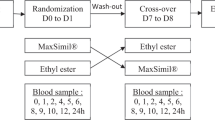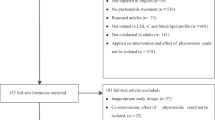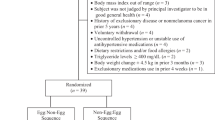Abstract
Background/Objectives: To assess safety during a diet based on low-fat foods enriched with nonesterified wood-derived plant sterols and mineral nutrients related to serum phytosterol, sex hormone and fat-soluble vitamin metabolism.
Subjects/Methods: Seventy-one study participants (52 women, 19 men) with mild-to-moderate hypercholesterolemia completed the double-blind, placebo-controlled feeding trial lasting for 15 weeks. The subjects were randomly allocated to the sterol group receiving food items enriched with mineral nutrients as well as with a total of 1.25, 2.5 and 5.0 g per day of plant sterols during the first, second and third 5-week periods, respectively, or to the placebo group receiving similar food items without plant sterols. This outpatient clinical trial with free-living subjects was carried out at two hospital clinics.
Results: Two significant findings were observed. Serum sitosterol concentrations increased from 2.84 to 5.35 mg l−1 (P<0.004 vs placebo) but those of serum total plant sterols did not because of compensatory changes in other phytosterols. The highest plant sterol levels did not exceed 0.6% of total serum sterols. Serum α-tocopherol concentrations decreased in the sterol group by 10% (P<0.0002), but the between-group difference disappeared after adjusting for the change in the carrier (LDL cholesterol).
Conclusions: Fifteen-week consumption of natural nonesterified plant sterol-enriched food does not cause any serious adverse effects during such a period. However, serum α-tocopherol levels were somewhat reduced in the sterol group suggesting that long-term effects of plant sterols on serum fat-soluble vitamin concentrations should be further explored, especially in relation to very low-fat diets.
This is a preview of subscription content, access via your institution
Access options
Subscribe to this journal
Receive 12 print issues and online access
$259.00 per year
only $21.58 per issue
Buy this article
- Purchase on Springer Link
- Instant access to full article PDF
Prices may be subject to local taxes which are calculated during checkout
Similar content being viewed by others
References
Ayesh R, Weststrate JA, Drewitt PN, Hepburn PA (1999). Safety evaluation of phytosterol esters. Part 5. Faecal short-chain fatty acid and microflora content, faecal bacterial enzyme activity and serum female sex hormones in healthy normolipidaemic volunteers consuming a controlled diet either with or without a phytosterol ester-enriched margarine. Food Chem Toxicol 37, 1127–1138.
Berge KE, von Bergmann K, Lutjohann D, Guerra R, Grundy SM, Hobbs HH et al. (2002). Heritablity of plasma noncholesterol sterols and relationship to DNA sequence polymorphism in ABCG5 and ABCG8. J Lipid Res 43, 486–494.
Expert Panel on Detection, Evaluation, and Treatment on High Blood Cholesterol in Adults (Adult Treatment Panel III (2001). Executive Summary of the Third Report of the National Cholesterol Education Program (NCEP). JAMA 285, 2486–2497.
Friedewald WT, Levy RI, Fredrickson DS (1972). Estimation of the concentration of low-density lipoprotein cholesterol in plasma, without use of the preparative ultracentrifuge. Clin Chem 18, 499–502.
Gylling H, Miettinen TA (1999). Cholesterol reduction by different plant stanol mixtures and with variable fat intake. Metabolism 48, 575–580.
Gylling H, Puska P, Vartiainen E, Miettinen TA (1999a). Serum sterols during stanol ester feeding in a mildly hypercholesterolemic population. J Lipid Res 40, 593–600.
Gylling H, Puska P, Vartiainen E, Miettinen TA (1999b). Retinol, vitamin D, carotenes and alpha-tocopherol in serum of a moderately hypercholesterolemic population consuming sitostanol ester margarine. Atherosclerosis 145, 279–285.
Haapa E, Toponen T, Pietinen P, Räsänen L (1985). Annoskuvakirja (Portion size booklet) (in Finnish). National Public Health Institute of Finland and University of Helsinki, Department of Nutrition: Helsinki.
Hallikainen MA, Sarkkinen ES, Uusitupa MI (1999). Effects of low-fat stanol ester enriched margarines on concentrations of serum carotenoids in subjects with elevated serum cholesterol concentrations. Eur J Clin Nutr 53, 966–969.
Jones PJH, MacDougall DE, Ntanios F, Vanstone CA (1997). Dietary phytosterols as cholesterol-lowering agents in humans. Can J Physiol Pharmacol 75, 217–227.
Kwiterowich Jr PO, Chen SC, Virgil DG, Schweitzer A, Arnold DR, Kratz LE (2003). Response of obligate heterozygotes for phytosterolmia to a low-fat diet and to a plant sterol ester dietary challenge. J Lipid Res 44, 1143–1155.
Lutjohann D, Björkhem I, Ose L (1996). Phytosterolaemia in a Norwegian family: diagnosis and charcterization of the first Scandinavian case. Scand J Clin Lab Invest 56, 229–240.
Malini T, Vanithakumari G (1993). Effect of beta-sitosterol on uterine biochemistry: a comparative study with estradiol and progesterone. Biochem Mol Biol Int 31, 659–668.
Mellanen P, Petänen T, Lehtimäki J, Mäkelä S, Bylund G, Holmbom B et al. (1996). Wood-derived estrogens: studies in vitro with breast cancer cell lines and in vivo in trout. Toxicol Appl Pharmacol 136, 381–388.
Miettinen TA (1980). Phytosterolaemia, xanthomatosis and premature atherosclerotic arterial disease: a case with high plant sterol absorption, impaired sterol elimination and low cholesterol synthesis. Eur J Clin Invest 10, 27–35.
Miettinen TA, Puska P, Gylling H, Vanhanen H, Vartiainen E (1995). Reduction of serum cholesterol with sitostanol-ester margarine in a mildly hypercholesterolemic population. N Engl J Med 333, 1308–1312.
Ovaskainen M-L, Valsta L, Lauronen J (1996). The compilation of food analysis values as a database for dietary studies—the Finnish experience. Food Chem 57, 133–136.
Patel MD, Thompson PD (2006). Phytosterols and vascular disease. Atherosclerosis 186, 12–19.
Patel SB, Salen G, Hidaka H, Kwiterowich PO, Stalenhoef AF, Miettinen TA et al. (1998). Mapping a gene involved in regulating dietary cholesterol absorption. The sitosterolemia locus is found at chromosome 2p21. J Clin Invest 102, 1041–1044.
Phillips KM, Ruggio DM, Bailey JA (1999). Precise quantitative determination of phytosterols, stanols, and cholesterol metabolites in human serum by capillary gas-liquid chromatography. J Chromatogr B Biomed Sci Appl 732, 17–29.
Pietinen P, Hartman AM, Haapa E, Räsänen L, Haapakoski J, Palmgren J et al. (1988). Reproducibility and validity of dietary assessment instruments. II. A qualitative food frequency questionnaire. Am J Epidemiol 128, 667–676.
Porkkala-Sarataho E, Nyyssönen K, Salonen JT (1996). Increased oxidation resistance of atherogenic plasma lipoproeins at high vitamin E levels in non-vitamin E supplemented men. Atherosclerosis 124, 83–94.
Salen G, Shefer S, Nguyen L, Ness GC, Tint GS, Shore V (1992). Sitosterolemia. J Lipid Res 33, 945–955.
SAS Procedures Guide. SAS Procedures Guide, Version 6 3rd edn. (1990): SAS Institute Inc: Cary, NC, USA.
Sugiuchi H, Uji Y, Okabe H, Irie T, Uekama K, Kayahara N et al. (1995). Direct measurement of high-density lipoprotein cholesterol in serum with polyethylene glycol-modified enzymes and sulfated alpha-cyclodextrin. Clin Chem 41, 717–723.
Tikkanen MJ (2005). Plant sterols and stanols. Handb Exp Pharmacol 170, 215–230.
Tikkanen MJ, Högström P, Tuomilehto J, Keinänen-Kiukaanniemi S, Sundvall J, Karppanen H (2001). Effect of a diet based on low-fat foods enriched with non-esterifed plant sterols and mineral nutrients on serum cholesterol. Am J Cardiol 88, 1157–1162.
Weststrate JA, Meijer GW (1998). Plant sterol-enriched margarines and reduction of plasma total- and LDL-cholesterol concentrations in normocholesterolaemic and mildly hypercholesterolaemic subjects. Eur J Clin Nutr 52, 334–343.
Ziouzenkova O, Winklhoofer-Roob BM, Puhl H, Roob JM, Esterbauer H (1996). Lack of correlation between the alpha-tocopherol content of plasma and LDL, but high correlations for gamma-tocopherol and carotenoids. J Lipid Res 37, 1936–1946.
Acknowledgements
This study was partly supported by TEKES, Finland. We are grateful for the assistance of Pirjo Härkönen, RN, Eija Lahdensuo, RN, and Marjo Mannelin, MSc, for their contribution in this study.
Author information
Authors and Affiliations
Corresponding author
Additional information
Guarantor: MJ Tikkanen.
Contributors: JT was responsible for supervision and planning of the study and participated in writing the article, MJT for interpretation of the results and writing the article, PH for coordination of the study and statistical analysis of data. SK-K coordinated the study at the Oulu centre, VP and JT developed the quantitative method and performed the measurement of plant sterols. JTS and KN determined the concentrations of fat-soluble vitamins. U-HS and HA carried out the hormone determinations, and HK was the inventor of the plant sterol preparation and responsible for planning and designing the study. SK-K, VP, JT, JTS, KN, U-HS, HA and HK helped in finalizing the article.
Duality of interest
Dr Heikki Karppanen is the main inventor of the wood sterol-mineral salt concept, which has been patented in several countries. If sold, he may receive patent-based royalties.
Rights and permissions
About this article
Cite this article
Tuomilehto, J., Tikkanen, M., Högström, P. et al. Safety assessment of common foods enriched with natural nonesterified plant sterols. Eur J Clin Nutr 63, 684–691 (2009). https://doi.org/10.1038/ejcn.2008.11
Received:
Revised:
Accepted:
Published:
Issue Date:
DOI: https://doi.org/10.1038/ejcn.2008.11
Keywords
This article is cited by
-
Randomized controlled trial of the effect of phytosterols-enriched low-fat milk on lipid profile in Chinese
Scientific Reports (2017)
-
Cholesterol-lowering effect of plant sterols
Current Atherosclerosis Reports (2008)



